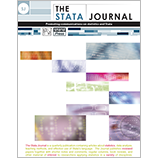Copula-based maximum-likelihood estimation of sample-selection models
Takuya Hasebe
Graduate Center, City University of New York
New York, NY
[email protected]
|
Abstract. Sample-selection issues are common problems in empirical studies of labor economics
and other applied microeconomics. A common estimation method is maximum likelihood
estimation under the assumption of joint normality. It is well known, however,
that the violation of distributional assumptions leads to inconsistency of a maximum
likelihood estimator. Early work on sample-selection models that relaxes the normality
assumption was done by Lee (1983, 1984). His approach was to transform nonnormal
disturbances in the models into normal variates that are then assumed to be jointly
normally distributed. As we will see, this is a special case of the copula approach
that Smith (2003) applies to sample-selection models. The copula approach adds more
flexibility to model specifications.
In this article, I discuss the maximum likelihood estimation of sample-selection models
with the copula approach to relax the assumption of joint normality. Although there
are several types of sample-selection models, I discuss two in particular: a bivariate
sample-selection model and an endogenous switching regression model. I also introduce
the Stata commands heckmancopula and switchcopula, which implement the
estimation of each model, respectively.
View all articles by this author:
Takuya Hasebe
View all articles with these keywords:
heckmancopula, switchcopula, copula method, sample-selection models
Download citation: BibTeX RIS
Download citation and abstract: BibTeX RIS
|
